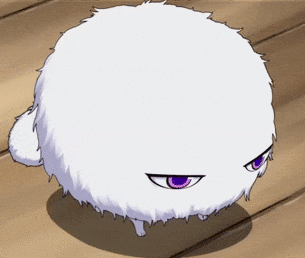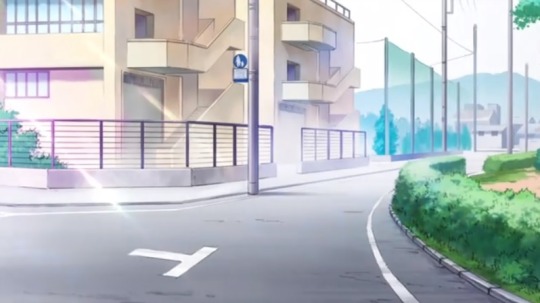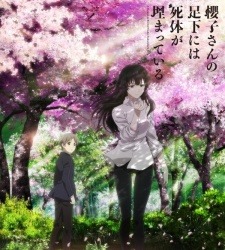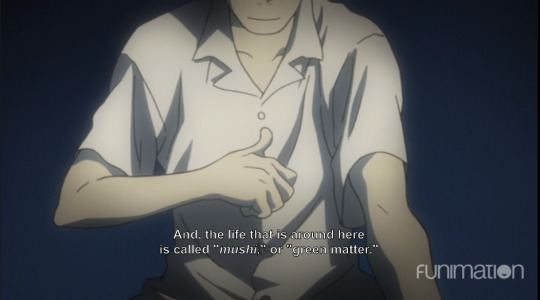Text
Fukigen na Mononokean: High school just got even more demonic
youtube
Figure 1. Fukigen na Mononokean opening credits (2016)
What do you get when you cross demons, slice-of-life, and high school? Fukigen na Mononokean, aka The Morose Mononokean, that’s what; an anime based on the manga of the same name written by Wazawa Kiri. The story is about a high schooler named Ashiya Hanae who comes across a fluffy, life-draining demon on his way back from the grocery store, which leads to him promptly passing out before he can even begin his first day of classes. Desperate for a solution, he calls Abeno Haruitsuki, an advertised exorcist and master of the Mononokean. Now in his debt, Ashiya becomes Abeno’s employee, only to find out that they are classmates the next day!

Figure 2. Cover art of volume 1, featuring Abeno (2016)
For being a comedic anime, there are surprisingly deep messages and moments within. For example, during many of the jobs Abeno and Ashiya take, there is a conflict between the two of them on how to go about solving it. Abeno, who has lived around demons his entire life, is used to getting the job done as painlessly as possible, but Ashiya, a kind-hearted and thoughtful person who has only discovered the existence of demons recently, always tries for the best outcome possible, disregarding the risks. The question remains: is the ideal outcome always worth the risks?

Figure 3. To take or not to take the parasite shrub medicine? (Screenshot taken from Episode 2)
Not only that, but the show likes to highlight the stark differences between human and demon culture by putting both side by side using novice Ashiya to ask questions and react like a normal human would. On one side you have the demons: an invisible race existing alongside yet not being noticed by humans. Then you have the humans: neither seeing nor believing in the demons, who often (regardless of intention) cause pain through their ignorance. Beyond that, the demons are very distinct in appearance, which only seems to widen the gap between both races. In most cases, demons look closer to an animal or plant (excluding the more powerful ones), and their animations have a 3D, CGI-esque style that normal, human animation doesn’t have. With only a select few humans able to even communicate with demons, bridging the gap between the two seems nearly impossible; they are too different to connect with each other. At least, that’s what Abeno thinks, having been around demons his whole life, despite being human himself.

Figure 4. Fuzzy showing off the non-traditional CGI animation of demons. (2017)

Figure 5. Big Boss Scree with a Little Scree (2016)

Figure 6. Koura, a humanoid demon (2016)
But is that truly the case? Abeno and Ashiya only need to throw on a kimono to be accepted into the more traditional setting of the Underworld, where the demons like to reside. Ashiya is a very dangerous wildcard according to many of the leaders of the Underworld, but he has proven that he only ever wants to help demons he interacts with, often going further than any attempt Abeno would have made on his own. It is a lesson on not judging a book by its cover; a lesson to give everyone a chance to prove themselves before passing judgment, otherwise you risk making unnecessary enemies, even if malice was unintentional.
Finally, I have already mentioned the difference in appearance between humans and demons, but I haven’t touched on their worlds. Let’s talk about aesthetic for a second before we conclude:

Figure 7. The “normal” human world (Screenshot taken from Episode 1)

Figure 8. The Underworld (2016)
The underworld is comparatively more traditional in culture, and that reflects in the art style. As you can see in the pictures above, the Underworld’s design is clearly inspired by the Edo-period’s iconic Ukiyo-e style of painting and wood-block printing; it is very flat compared to the human world, and the colors are unrealistic enough to have noticeable difference in appearance. However, even then, there are many similarities. Contrary to the typical dark scene people picture when thinking about the “underworld”, it is a bright and peaceful place with the domestic feel of daily life. Even the architecture isn’t so far from human standards (discounting the colors, of course). Once again, the viewer is reminded of how demons and humans aren’t necessarily so different after all.
So, why would I recommend this anime? It has a good balance between humor and drama, the art style is very bright and attractive, and the over-arching message it presents is relevant and important to people of all ages. Well, that and a second season has been green-lit (as of June 22nd)! Now is the time to hop on the Fukigen na Mononokean train so you can be ready when the new episodes come out this January!
References:
Mine Ischisawa. (2016). Fukigen na mononokean OP [ Tomodachi Meter\TV SIZE] [トモダチメートル] [Video]. Retrieved from https://www.youtube.com/watch?v=UivqKQZEbXc
G S Palmer. (2016). The Morose Mononokean, volume 1. Retrieved from https://en.wikipedia.org/wiki/File:The_Morose_Mononokean,_volume_1.jpg
chika/eliena. (2017) Just some cute Fuzzy moments. Retrieved from https://aminoapps.com/c/anime/page/blog/just-some-cute-moment-of-fuzzy/Rqtw_uWZbrLxJ0DMjkprnZKpKoN3Pg
Crunchyroll. (2016). The Morose Mononokean Episode 2 – The Ant. Retrieved from https://www.crunchyroll.com/the-morose-mononokean/episode-2-the-ant-715087
Preussen Gilbert. (2016) Big Boss Scree. Retrieved from http://fukigen-na-mononokean.wikia.com/wiki/Big_Boss_Scree?file=Big%20Boss%20Scree.png
MyAnimeList. (2016). Koura. Retrieved from https://myanimelist.net/character/140994/Koura
Crunchyroll. (2016). The Morose Mononokean Episode 1 – The Beginning. Retrieved from https://www.crunchyroll.com/the-morose-mononokean/episode-1-the-beginning-715085
Stark700. (2016). The Underworld. Retrieved from https://myanimelist.net/forum/?topicid=1534995
Mikikazu Komatsu. (2018). “TV Anime The Morose Mononokean Gets Its Second Season” Retrieved from https://www.crunchyroll.com/anime-news/2018/06/21/tv-anime-the-morose-mononokean-gets-its-second-season
comic_natalie. (2018, Oct 10). 「不機嫌なモノノケ庵」2期のメインビジュアル到着、“續”として来年1月放送. [Tweet] Retrieved from https://twitter.com/comic_natalie/status/1050219712368467968
0 notes
Text
Beautiful Bones: A Mystery of All Types of Remains
vimeo
Figure 1. Sakurako-san no Ashimoto ni wa Shitai ga Umatteiru opening credits (2015)
Sakurako-san no Ashimoto ni wa Shitai ga Umatteiru also known as A Corpse is Buried Under Sakurako's Feet, also also known as Beautiful Bones: Sakurako's Investigation, or just simply Beautiful Bones is an anime adapted from the light novel series of the same name(s) written by Shiori Ōta with illustrations by Tetsuo. In it, a modern, Japanese female Sherlock Homes, obsessed with skeletal remains named Kujou Sakurako and her high school aged Watson named Tatewaki Shoutarou solve mysteries by listening to bones. That’s it. That’s the show.

Figure 2. The cover for volume 1 of the light novel, featuring Shoutarou and Sakurako (Crystalyn Hodgkins, 2015)
In all seriousness, this anime is a hidden gem. Let me fill you in:
The show opens with a hauntingly elegant piano and a voice over, “I was born in a city where time has ceased to exist”, showing simple text on a white background. Technically this line is just a metaphor for “peace and quiet” as explained roughly 1 second later, but the point is you immediately get the sense that this show is heavy in figurative language and imagery. This remains true throughout. For example, death is a common topic, and many of the motifs are symbolic of it.

Figure 3. Key visual for the anime (Paul Chapman, 2015)
In the very first episode of the show they explain the existence of a story in Japan that states “dead bodies are buried underneath cherry trees”. The cherry tree, called “sakura” in Japanese, is present throughout. As Shoutarou is walking to school, sakura petals quietly fall down, and soon he discovers a cat dead in the road. He picks it up, then buries it in the school yard underneath – you guessed it – a sakura tree. Even the name Sakurako has the word “sakura” in it. It makes sense now that the title of the show is A Corpse is Buried Under Sakurako's Feet, doesn’t it? Beyond that, a simple butterfly is also a symbol of death. In the first episode, it is in reference to the sphenoid bone, which is a delicate bone inside the human skull which is in the shape of a butterfly. But wait! There’s more. Unfortunately, this gets into the grey area of spoiler territory, but let it be known that butterflies also represent a larger evil in the background.

Figure 4. Sphenoid bone. (Henry Gray via Wikimedia, 1918)

Figure 5. Lethe Diana* (Alpsdake, 2011)
That being said, there are also plenty of times that the subject of death is breached in a direct and even insensitive manner due to Sakurako’s nature. The depictions of bodies and remains can be graphic at times, but because it is the premise of the show, I believe that this is a reasonable design choice. As Shoutarou says in the first episode, “Real death gives people pause. As it should”, and the point being made is that Sakurako is not normal in that regard. In fact, she just gets excited!
In general, Beautiful Bones has very consistent visuals: high quality animation, but a basic design. However, certain moments shine through, like the one below.
youtube
Figure 6. Sakurako gets ready to solve a mystery (2018)
The wide array of colors. The bones all coming alive around Sakurako as she gets ready to listen to them. The fluidity of the wind in her hair and the whale over her head. The music. Even just the rhythm of her voice as she says her line (which translates to, “Now, let us solve the mystery”). They all come together to create a stunningly abstract, yet concrete vision. This concept of making the abstract real happens many times, especially when she is explaining her deductions. The characters all react to the images as if they were truly there, only to be thrown back into reality when she is done explaining. It gives the audience the sense that Sakurako’s words are so detailed they seem to come to life right before your eyes, while also giving a nice visual representation of otherwise hard to grasp information.
In conclusion, Beautiful Bones may seem average at first glance, but soon enough, it becomes clear that the depth of the characters, the music, the visuals, and more all meet to create an anime worth watching. That being said, I’ll say viewer discretion is advised for those particularly upset by the depiction and discussion of death and other heavy topics. Regardless, if you are looking for a mystery, this is an anime worth thinking about.
*An interesting species of butterfly known for its unique taste in meals…
References:
Otakuji. (2015). Sakurako-san no Ashimoto ni wa Shitai ga Umatteiru (Beautiful Bones: Sakurako’s Investigation) - Opening [Video]. Retrieved from https://vimeo.com/144238244
Crystalyn Hodgkins. (2015). Sakurako-san no Ashimoto ni wa Shitai ga Umatteiru light novel volume 1 cover. Retrieved from https://www.animenewsnetwork.com/news/2015-02-24/sakurako-san-no-ashimoto-ni-wa-shitai-ga-umatteiru-mystery-light-novels-get-anime/.85325
Paul Chapman. (2015). Key visual for the anime. Retrieved from https://www.crunchyroll.com/anime-news/2015/08/28/a-corpse-is-buried-under-sakurakos-feet-broadcast-details-announced
Henry Vandyke Carter, via Wikimedia Commons. (1918). Sphenoid bone. Anterior and inferior surfaces. Retrieved from https://commons.wikimedia.org/wiki/File:Gray146.png
Alpsdake (2011). Lethe Diana in mie prefecture forest park. Retrieved from https://commons.wikimedia.org/wiki/File:Lethe_diana_in_Mie_prefecture_forest_park_2011-08-07.jpg
Bang-bang Dam-dam. (2018). Beautiful Bones Sakurako's Investigation Cut-Scene EP01 VOSTFR [noGrp]. Retrieved from https://www.youtube.com/watch?v=ZcWzZigGamk
#sakurako-san no ashimoto ni wa shitai ga umatteiru#a corpse is buried under sakurako's feet#beautiful bones: sakurako's investigation#anime#anime reveiw
5 notes
·
View notes
Text
Mushi-Shi: A supernatural slice-of-life
youtube
Figure 1. Mushi-shi opening credits (2009)
Mushi-shi is an anime adapted from a manga of the same name by Yuki Urushibara. It follows a man named Ginko, who is a travelling “mushi-shi”, or a person who studies the beings called “mushi”. These beings are, in simple terms, so close to the essence of life that they are life itself. They go unseen by most human eyes and have strange effects on the world around them (both good and bad) and thus they are often feared by those who do not understand them.

Figure 2. Drawn depictions of basic forms of mushi (Screenshot taken from Episode 1)

Figure 3. The main character, Ginko (MyAnimeList)
The show itself presents itself from the start as a peaceful narrative. While the introduction to the beings called mushi is ominously voiced by a woman over the flickering candle-lit depictions of the mushi, the opening theme, “The Sore Feet Song” by Ally Kerr evokes a feeling of serenity on top of the abstract plant-like imagery. There are very few moments of what might be considered true tension within the narrative as a climax or crisis.
As implied by the beginning shots, nature is a common topic within the plot of the show. Set in what appears to be a slightly modified version of pre-industrialization Japan, there isn’t much in terms of technology or modern advances. This fact highlights the pervasiveness of nature as a topic. Many times during the show the relationship between mushi (which represent life), different aspects of nature (such as light and dark, or plants), and humanity is talked about through both literal and metaphorical means.

Figure 4. Mushi-Shi manga volume 1 cover art (MyAnimeList, 1999)
There is much symbolism behind many of the images relating to these ideas. For example (without spoilers), there is a green sake cup that has been broken perfectly in half that is used as a plot device during the first episode. It is a vibrant green, just like the plants introduced in the beginning shots, and the split sake cup represents a broken soul – someone who has lost half of themselves to the “other side” where the mushi live. The first episode also gives a useful analogy of the relationship between typical life forms and mushi compared to the relationship between the hand and the heart. Where humans are at the tip of the middle finger, furthest away from the heart, the animal kingdom consists of the pointer, ring, and pinky fingers, while plants are the thumb. If you keep going down, getting towards more basic life forms, you get to the wrist. Here is where the fungi are. It is a place where the lines between plant and animal begin to blur, just like the veins in your arm. You keep going all the way down the arm and finally reach the heart, which represents the essence of life itself. Here is where the mushi reside.

Figure 5. Ginko explaining the hand and heart analogy (Screenshot taken from Episode 1)
Most interesting, however, is the fact that the show has very little ties between the plots of most of its episodes. The structure is such that each episode for the most part is its own complete mini story, with its own characters and plots. Sometimes the show will even take on the point of view of one of the main characters of that episode as it begins. It sets up an intriguing dynamic where Ginko is both the main focus and an observer at the same time. This does, however, cause a distinct lack of coherent character growth and background. In fact, one of the main constants is the lack of a background for Ginko, which gets slowly filled in more over time.
There isn’t much I personally have an issue with regarding this show, however, I will say for a fact that I know it is not for everyone. It is a slow-paced series of slice of life style stories with very little over-arching plot to go with it, and sometimes that is a major turn off for people. That being said, for those who are willing to be patient and just experience this anime as it is, the show is wonderfully complex in all the right ways. Put that together with a lovely soundtrack, animation, and aesthetic design, and you have yourself a great way to spend some down time on a rainy day.
References:
Dino2jp. (2009). Mushishi – OP [Video]. Retrieved from https://www.youtube.com/watch?v=FZkYfPmIMAU
Funimation Productions, LLC. (2005) Mushi-Shi Episode 1: The Green Seat. Retrieved from https://www.funimation.com/shows/mushi-shi/the-green-seat/
MyAnimeLIst, LLC. (1999). Mushishi. Retrieved from https://myanimelist.net/manga/418/Mushishi?suggestion=
MyAnimeList, LLC. (Unknown). Ginko. Retrieved from https://myanimelist.net/character/425/Ginko
Funimation Productions, LLC. (2005) Mushi-Shi. Retrieved from https://www.funimation.com/shows/mushi-shi/
0 notes